An investigation into English language learning strategies employed by the first year English major students at school of foreign languages, Thai Nguyen University
The study investigates language learning strategies (LLSs) employed by first
year English major students at School of Foreign Languages (SFL), Thai Nguyen
University (TNU) and examines differences in the use of LLSs among students with
different language learning experiences measured by years of learning English. Two data
collection instruments used are a questionnaire adapted from the Strategy Inventory for
Language Learning (SILL) (Oxford, 1990) and an interview. The study was conducted with
the participation of 100 first year English major students at SFL, TNU. The results of the
study indicate that all the LLSs were used by the 100 participants. In addition, there were a
number of variations in the employment of LLSs among students with different language
learning experiences. It was found that the more experienced students used LLSs much
more frequently than the less experienced ones.
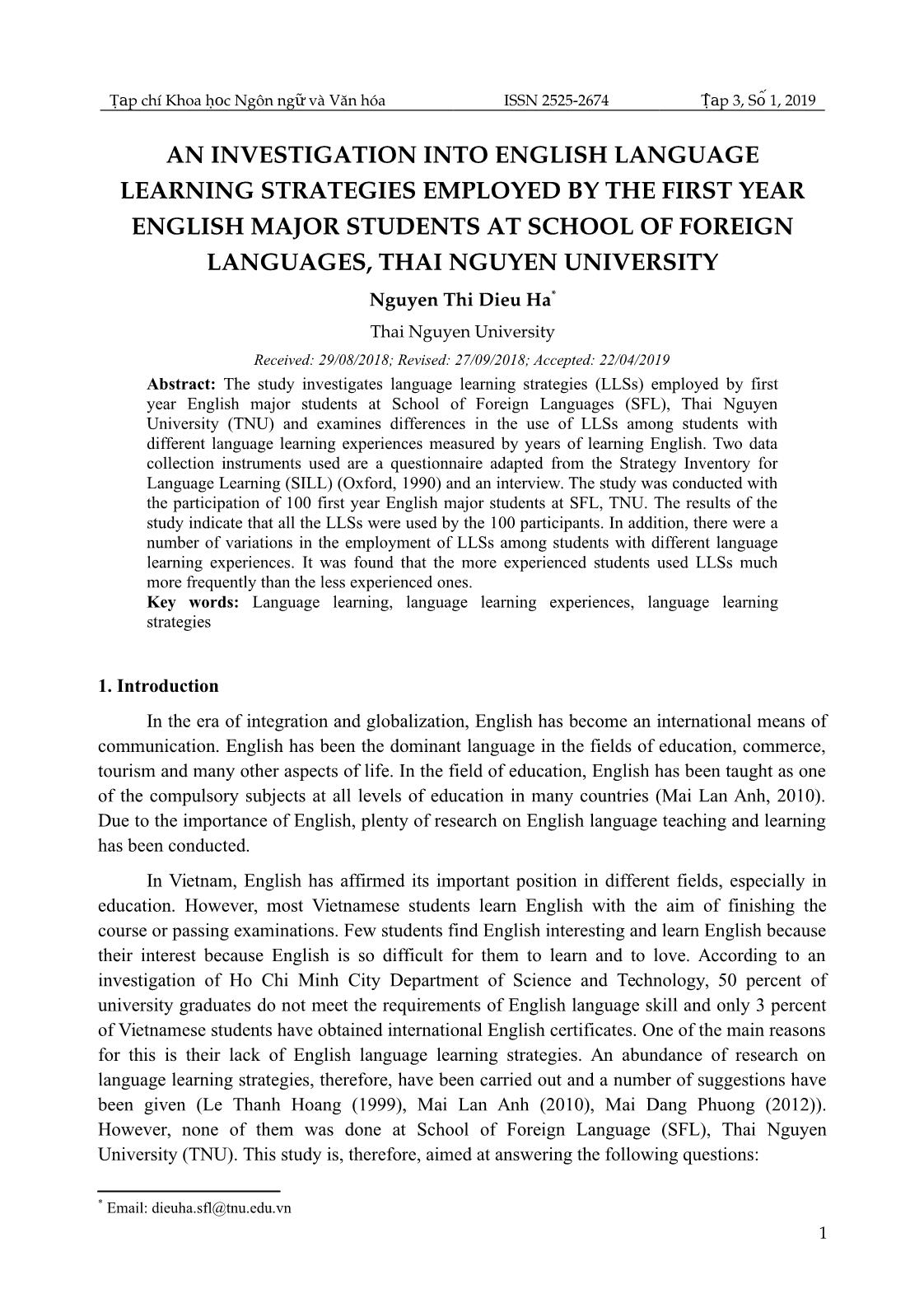
Trang 1
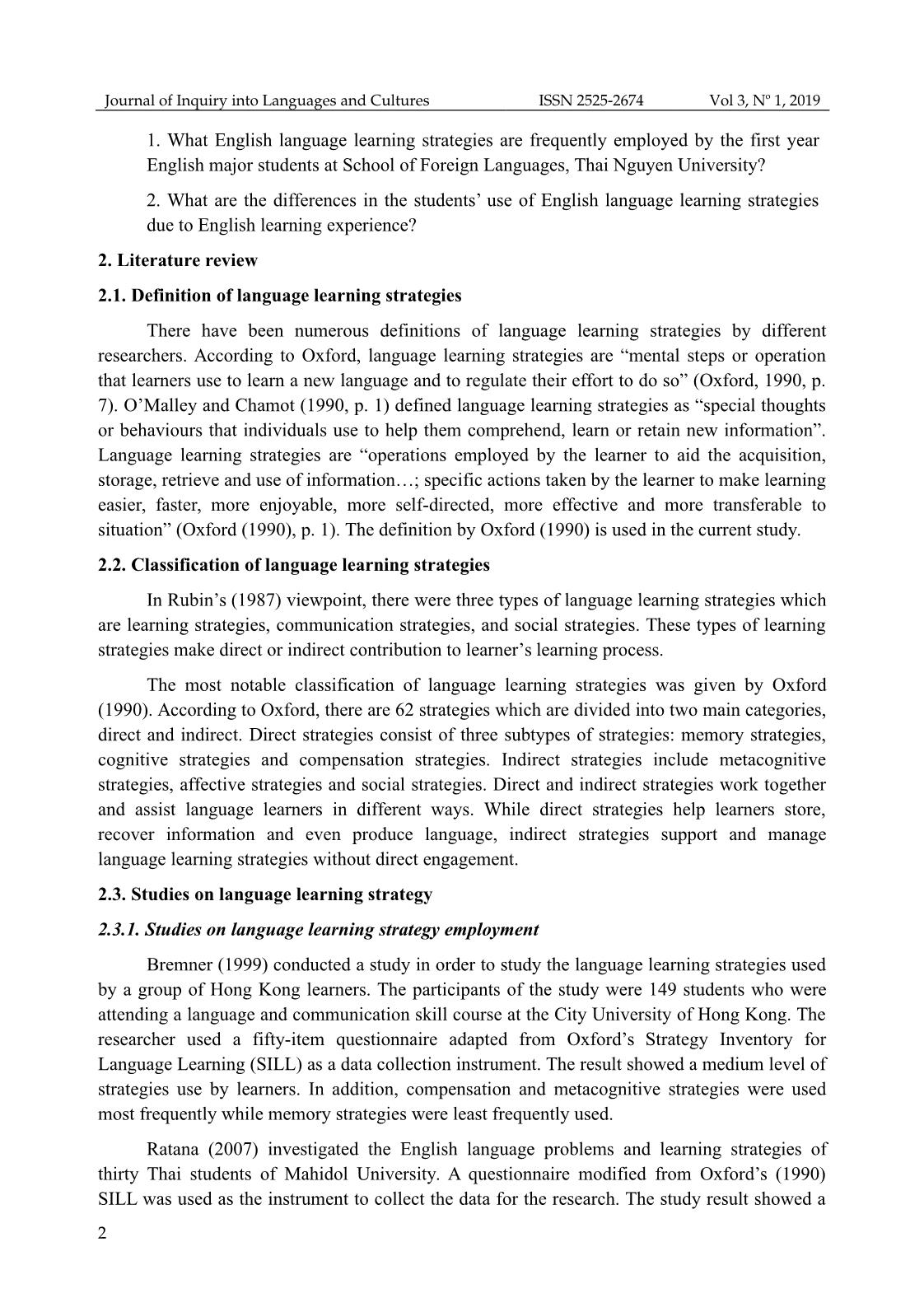
Trang 2
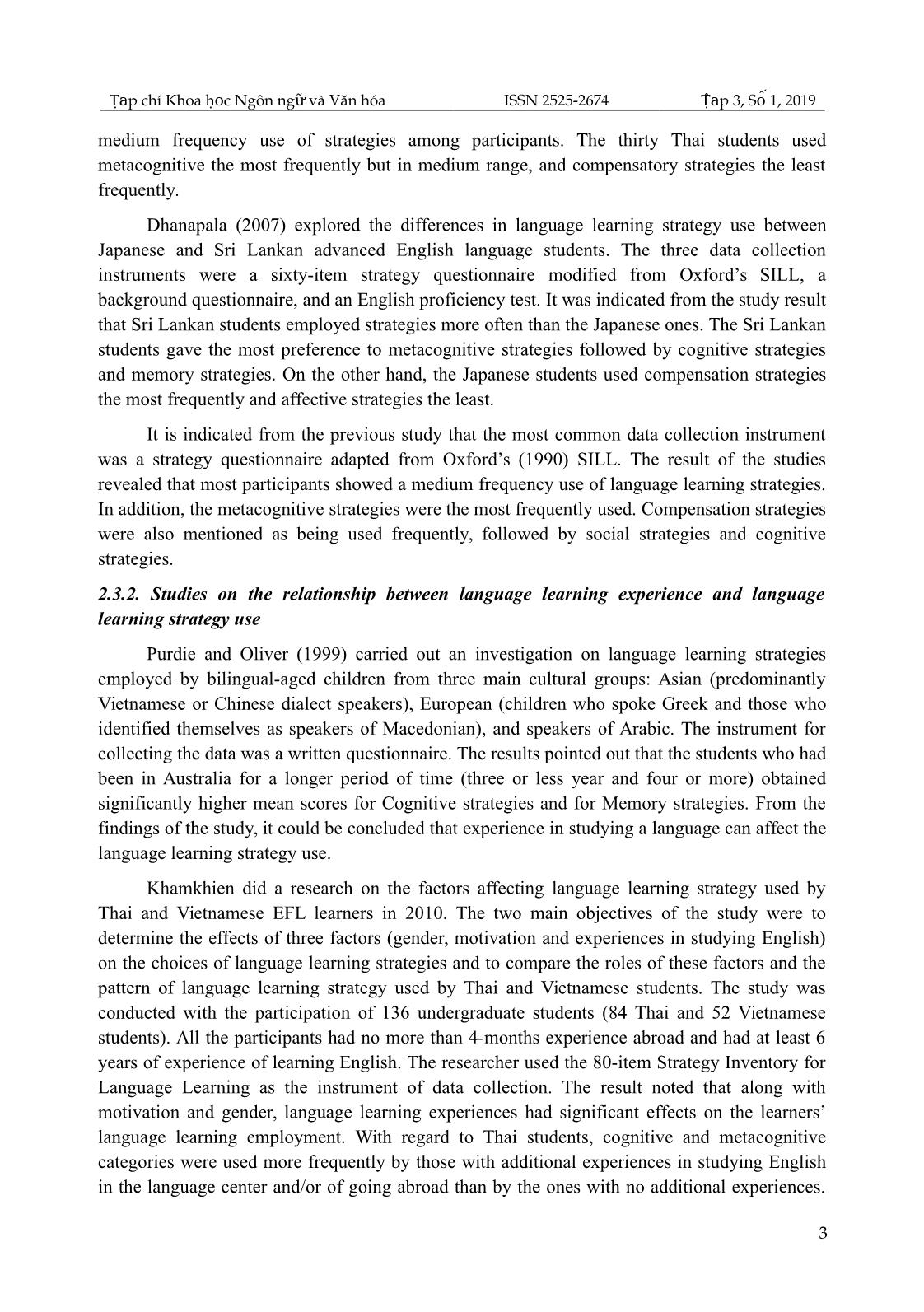
Trang 3
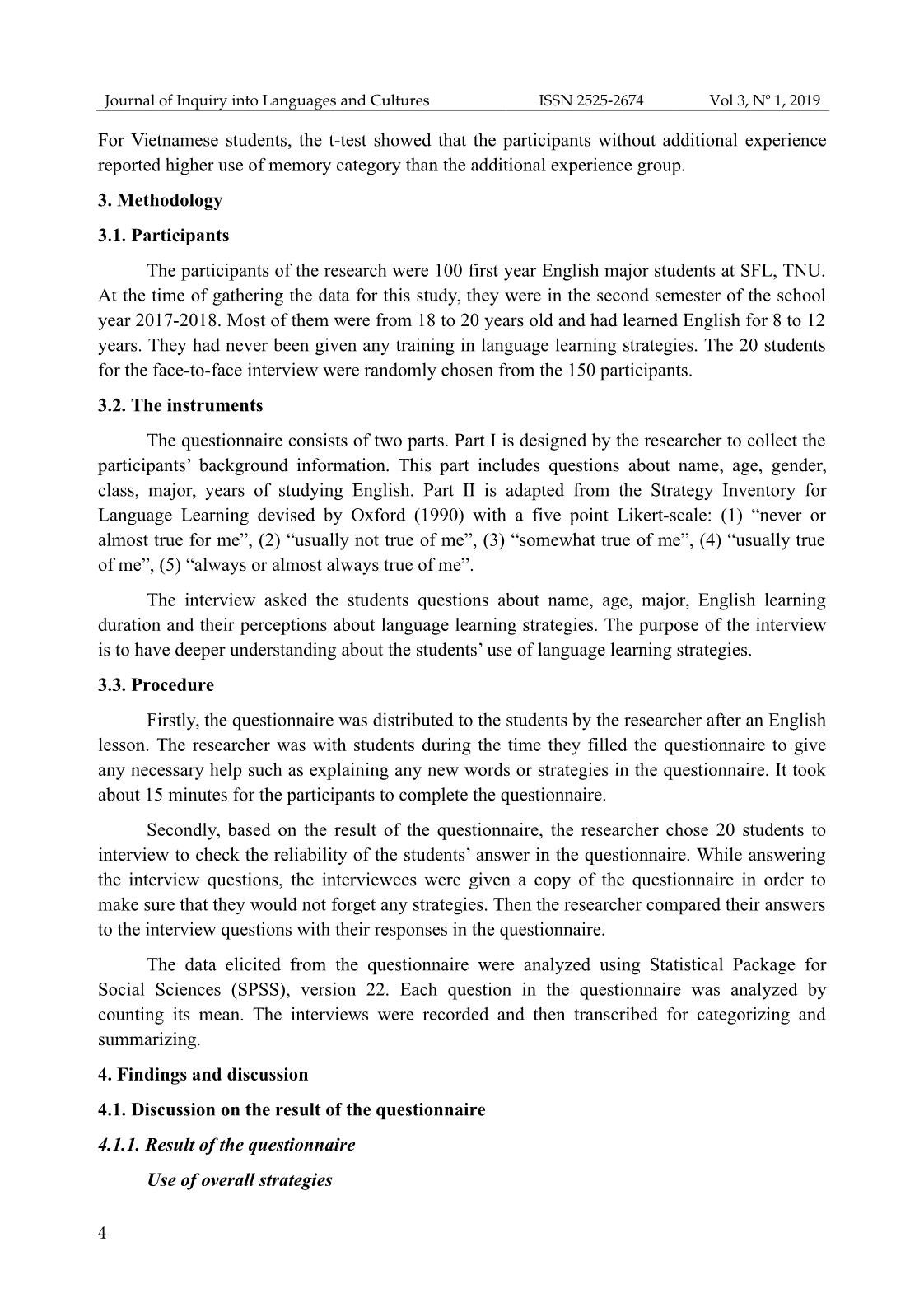
Trang 4
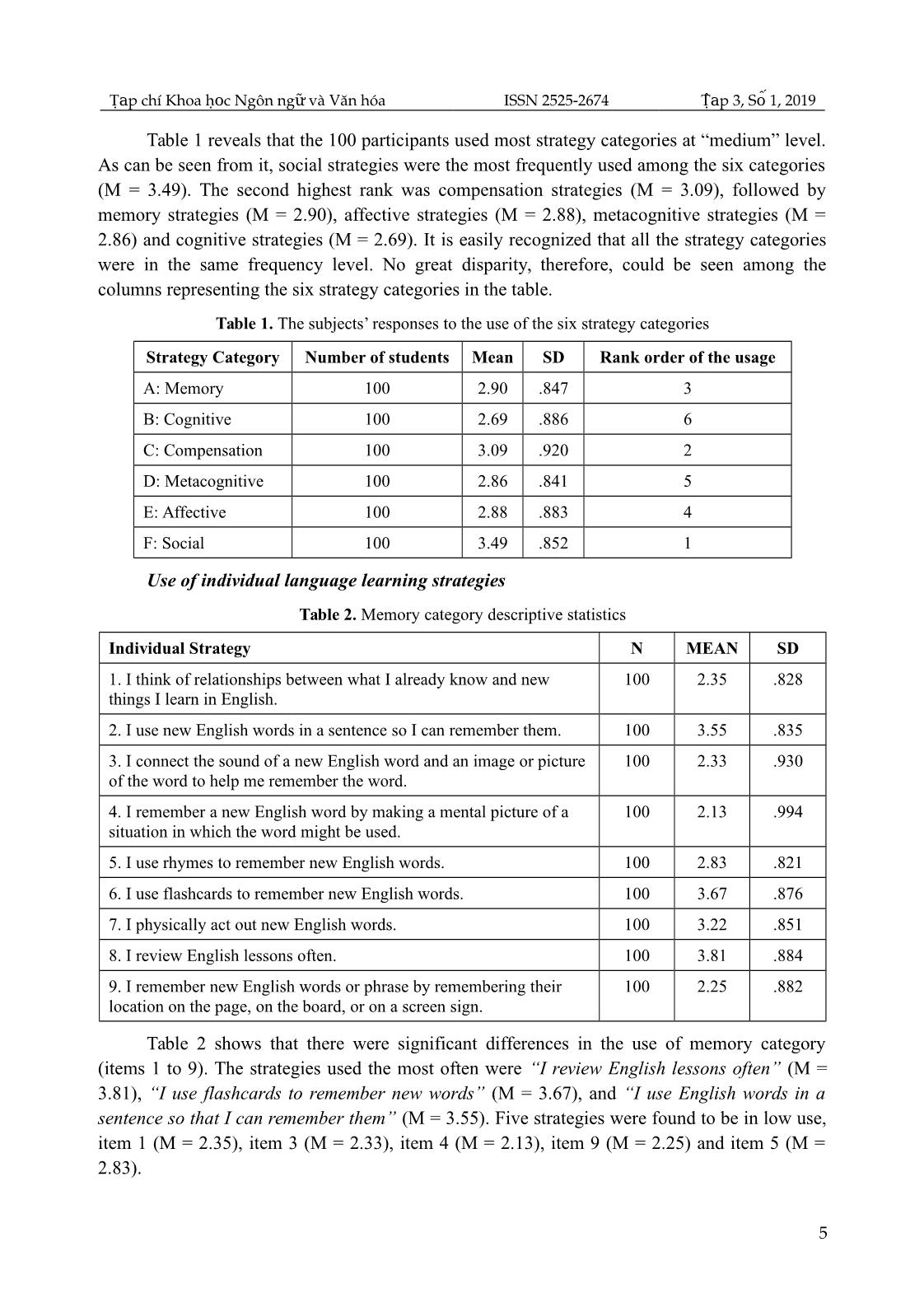
Trang 5
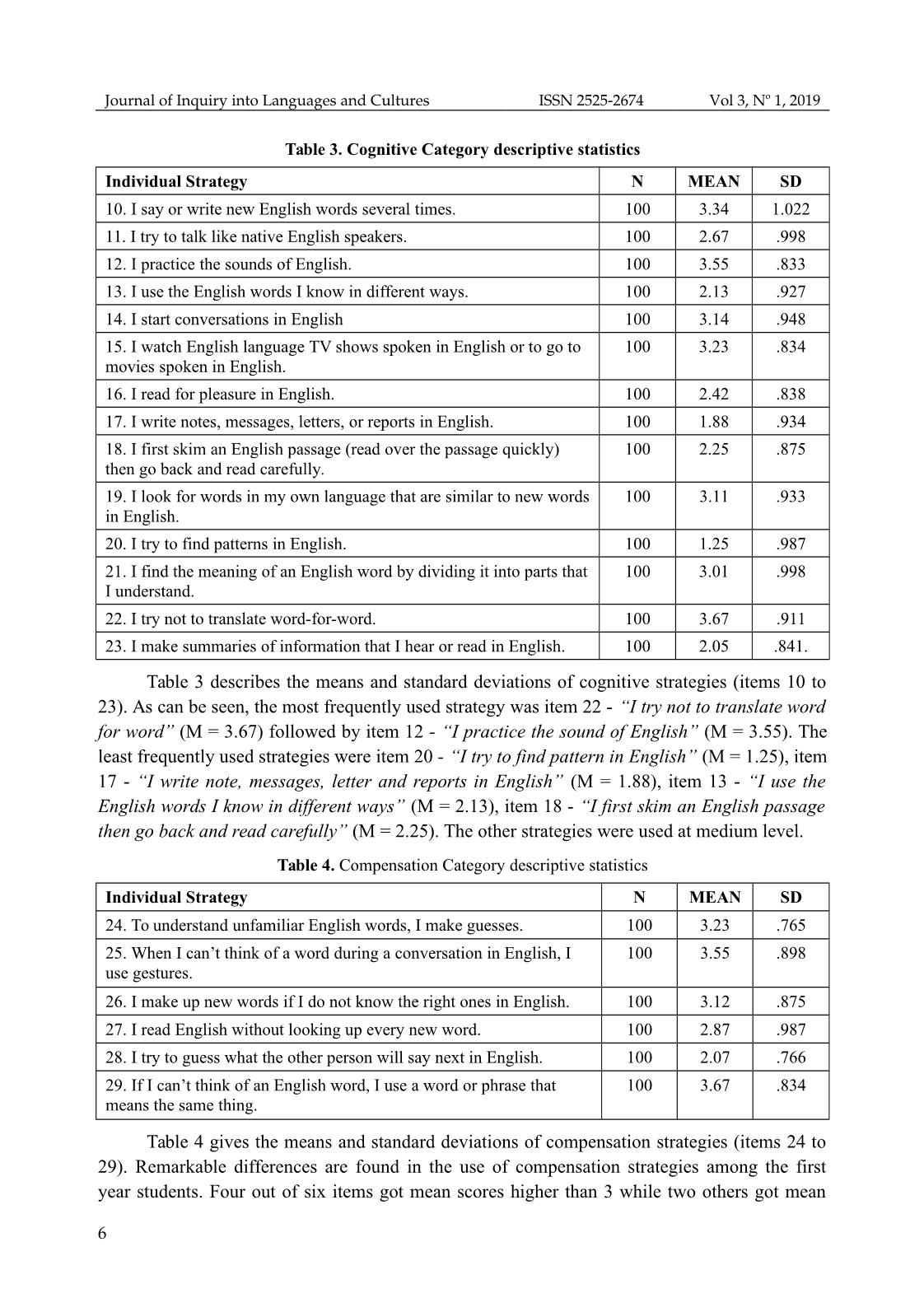
Trang 6
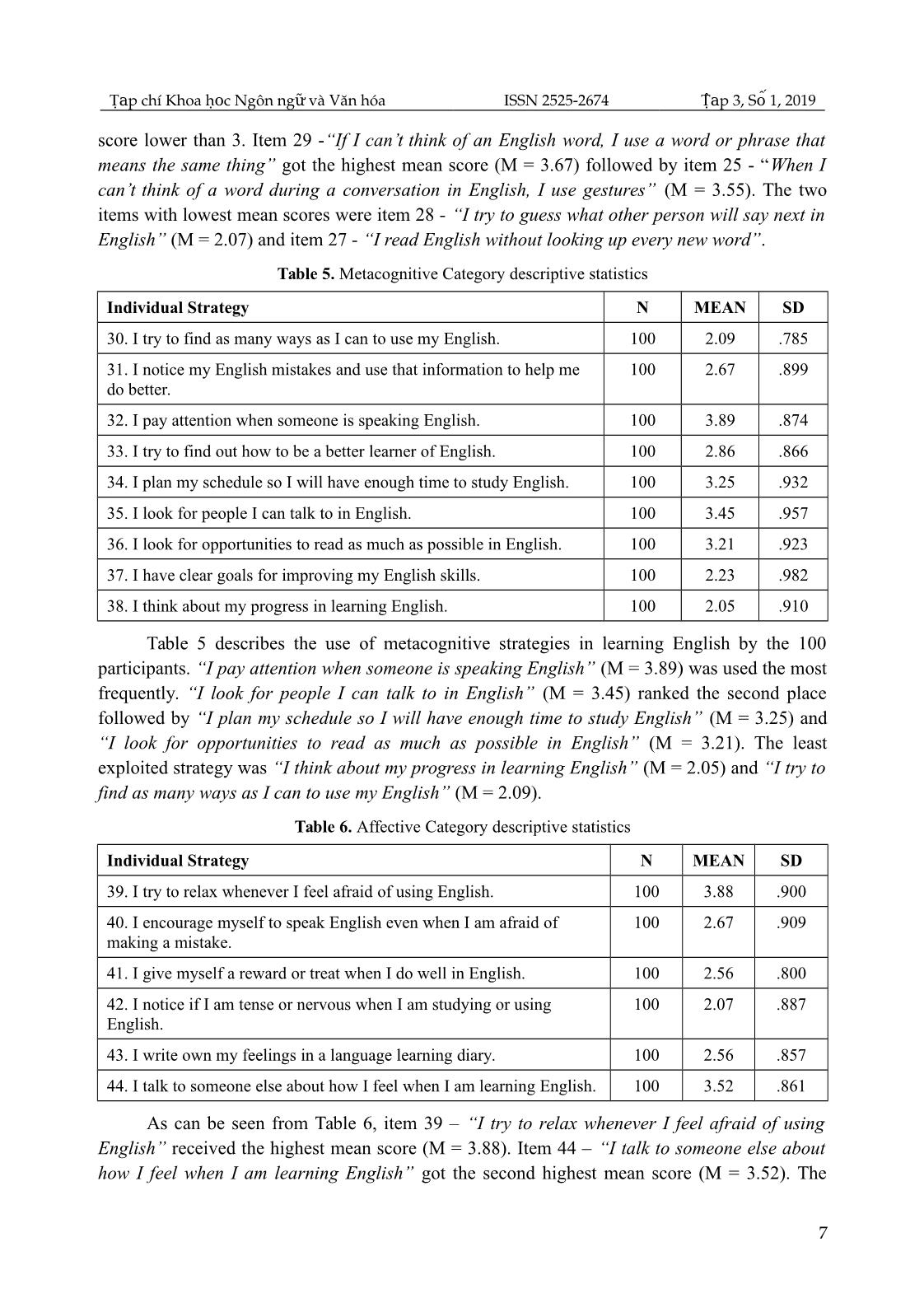
Trang 7
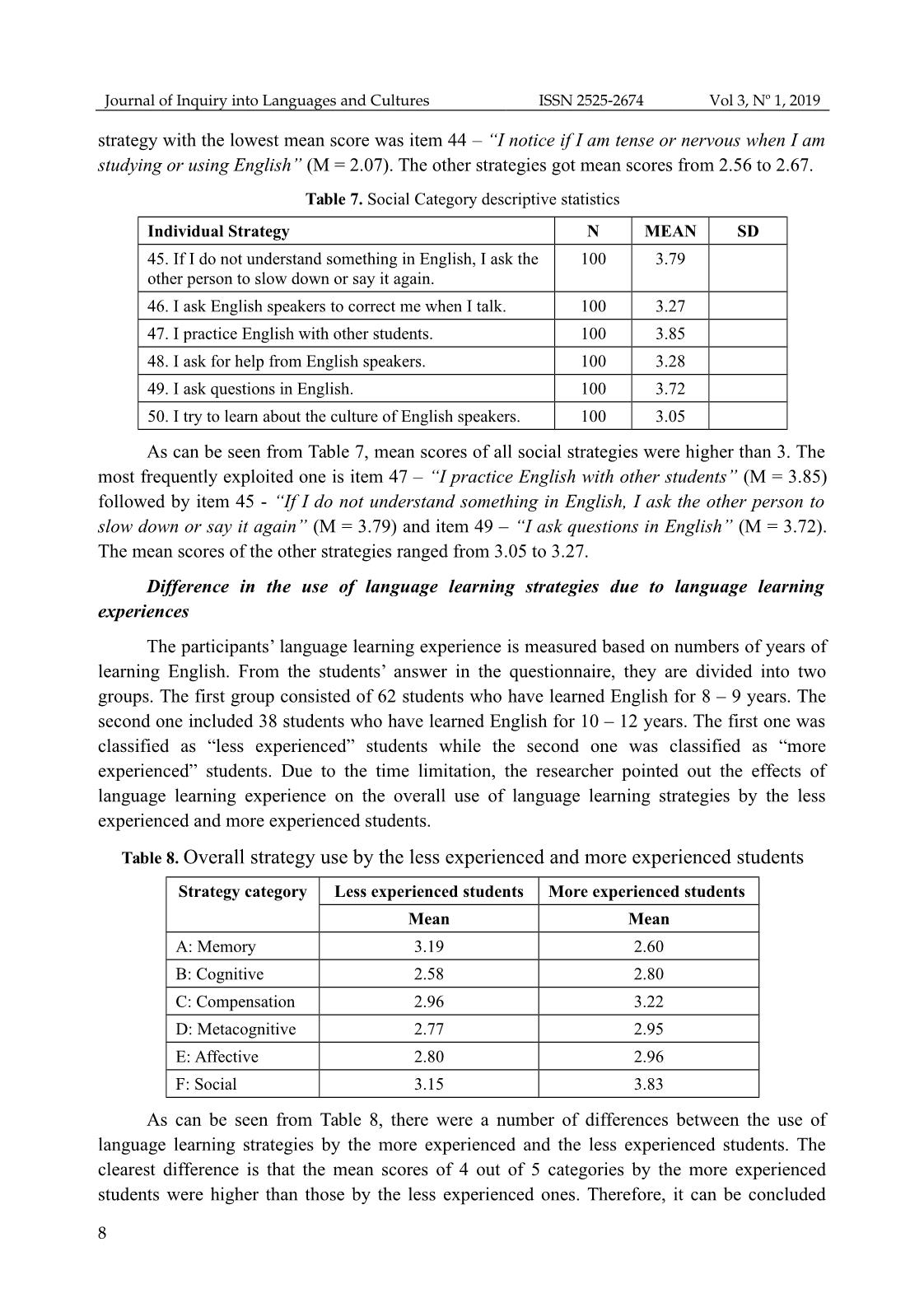
Trang 8
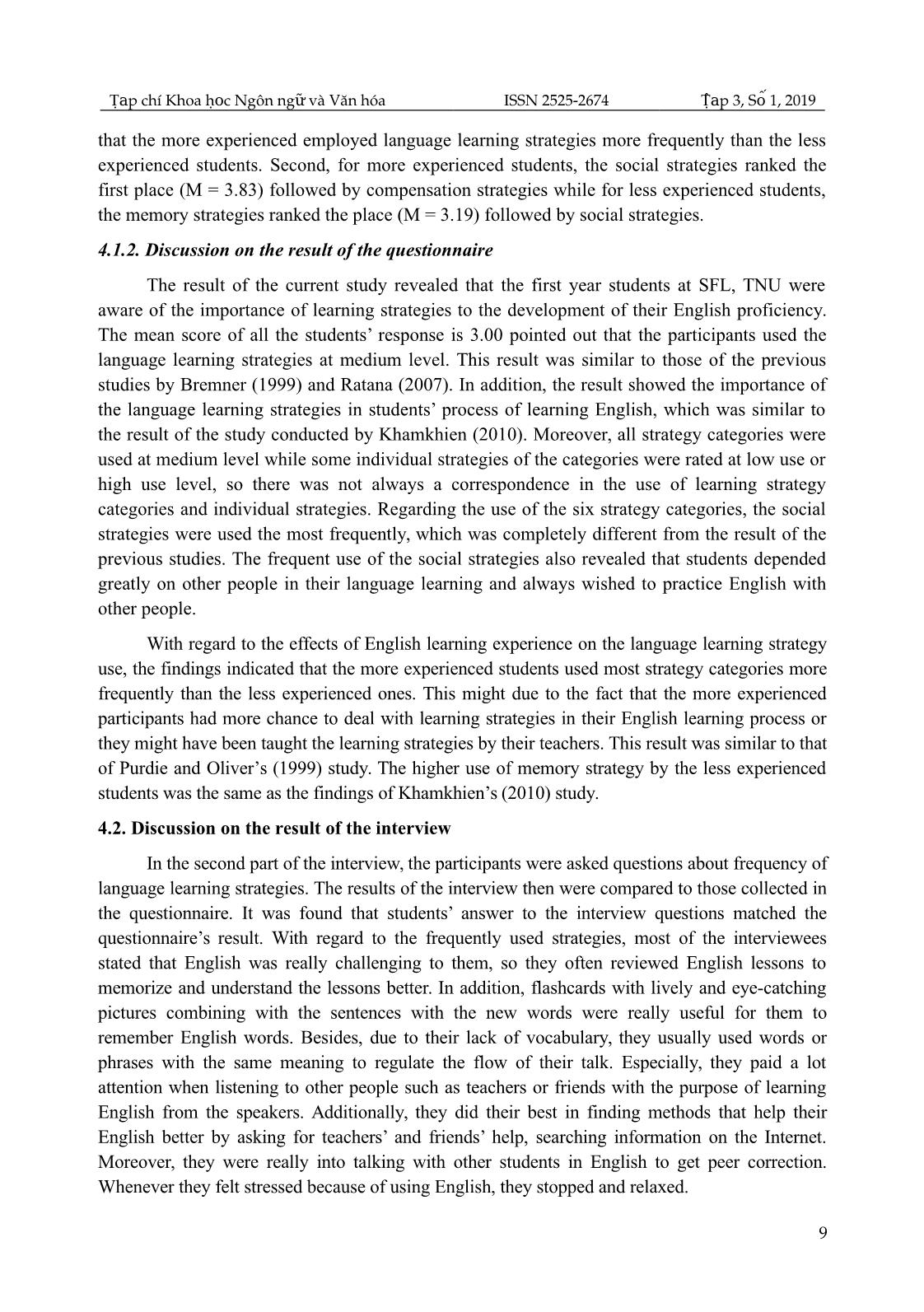
Trang 9
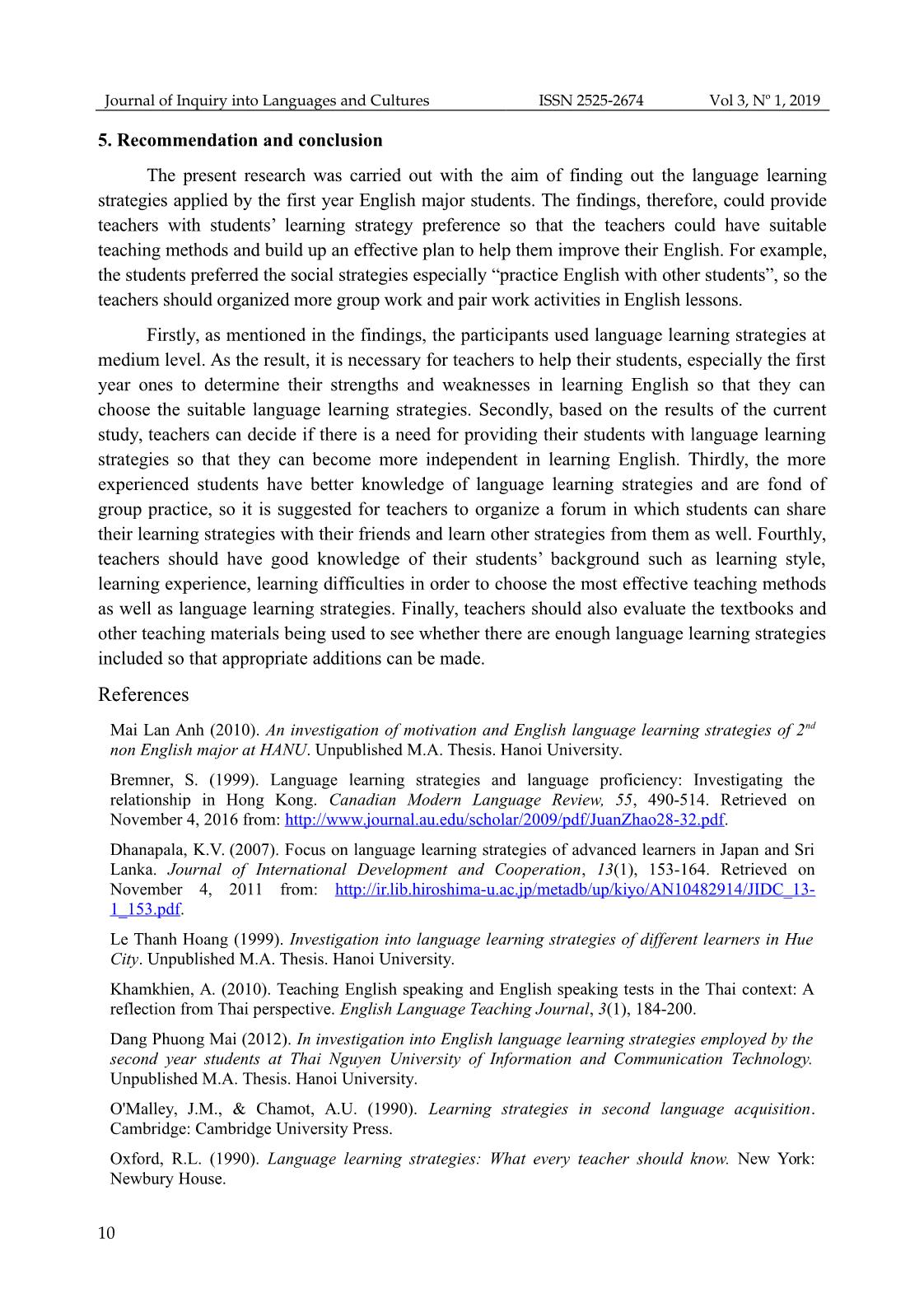
Trang 10
Tải về để xem bản đầy đủ
Tóm tắt nội dung tài liệu: An investigation into English language learning strategies employed by the first year English major students at school of foreign languages, Thai Nguyen University
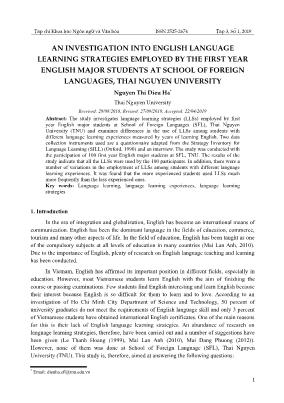
Table 4 gives the means and standard deviations of compensation strategies (items 24 to 29). Remarkable differences are found in the use of compensation strategies among the first year students. Four out of six items got mean scores higher than 3 while two others got mean 6 T p chí Khoa h c Ngôn ng và Văn hóaạ ọ ữ ISSN 25252674 T p 3, S 1, 2019ậ ố score lower than 3. Item 29 -“If I can’t think of an English word, I use a word or phrase that means the same thing” got the highest mean score (M = 3.67) followed by item 25 - “When I can’t think of a word during a conversation in English, I use gestures” (M = 3.55). The two items with lowest mean scores were item 28 - “I try to guess what other person will say next in English” (M = 2.07) and item 27 - “I read English without looking up every new word”. Table 5. Metacognitive Category descriptive statistics Individual Strategy N MEAN SD 30. I try to find as many ways as I can to use my English. 100 2.09 .785 31. I notice my English mistakes and use that information to help me do better. 100 2.67 .899 32. I pay attention when someone is speaking English. 100 3.89 .874 33. I try to find out how to be a better learner of English. 100 2.86 .866 34. I plan my schedule so I will have enough time to study English. 100 3.25 .932 35. I look for people I can talk to in English. 100 3.45 .957 36. I look for opportunities to read as much as possible in English. 100 3.21 .923 37. I have clear goals for improving my English skills. 100 2.23 .982 38. I think about my progress in learning English. 100 2.05 .910 Table 5 describes the use of metacognitive strategies in learning English by the 100 participants. “I pay attention when someone is speaking English” (M = 3.89) was used the most frequently. “I look for people I can talk to in English” (M = 3.45) ranked the second place followed by “I plan my schedule so I will have enough time to study English” (M = 3.25) and “I look for opportunities to read as much as possible in English” (M = 3.21). The least exploited strategy was “I think about my progress in learning English” (M = 2.05) and “I try to find as many ways as I can to use my English” (M = 2.09). Table 6. Affective Category descriptive statistics Individual Strategy N MEAN SD 39. I try to relax whenever I feel afraid of using English. 100 3.88 .900 40. I encourage myself to speak English even when I am afraid of making a mistake. 100 2.67 .909 41. I give myself a reward or treat when I do well in English. 100 2.56 .800 42. I notice if I am tense or nervous when I am studying or using English. 100 2.07 .887 43. I write own my feelings in a language learning diary. 100 2.56 .857 44. I talk to someone else about how I feel when I am learning English. 100 3.52 .861 As can be seen from Table 6, item 39 – “I try to relax whenever I feel afraid of using English” received the highest mean score (M = 3.88). Item 44 – “I talk to someone else about how I feel when I am learning English” got the second highest mean score (M = 3.52). The 7 Journal of Inquiry into Languages and Cultures ISSN 25252674 Vol 3, No 1, 2019 strategy with the lowest mean score was item 44 – “I notice if I am tense or nervous when I am studying or using English” (M = 2.07). The other strategies got mean scores from 2.56 to 2.67. Table 7. Social Category descriptive statistics Individual Strategy N MEAN SD 45. If I do not understand something in English, I ask the other person to slow down or say it again. 100 3.79 46. I ask English speakers to correct me when I talk. 100 3.27 47. I practice English with other students. 100 3.85 48. I ask for help from English speakers. 100 3.28 49. I ask questions in English. 100 3.72 50. I try to learn about the culture of English speakers. 100 3.05 As can be seen from Table 7, mean scores of all social strategies were higher than 3. The most frequently exploited one is item 47 – “I practice English with other students” (M = 3.85) followed by item 45 - “If I do not understand something in English, I ask the other person to slow down or say it again” (M = 3.79) and item 49 – “I ask questions in English” (M = 3.72). The mean scores of the other strategies ranged from 3.05 to 3.27. Difference in the use of language learning strategies due to language learning experiences The participants’ language learning experience is measured based on numbers of years of learning English. From the students’ answer in the questionnaire, they are divided into two groups. The first group consisted of 62 students who have learned English for 8 – 9 years. The second one included 38 students who have learned English for 10 – 12 years. The first one was classified as “less experienced” students while the second one was classified as “more experienced” students. Due to the time limitation, the researcher pointed out the effects of language learning experience on the overall use of language learning strategies by the less experienced and more experienced students. Table 8. Overall strategy use by the less experienced and more experienced students Strategy category Less experienced students More experienced students Mean Mean A: Memory 3.19 2.60 B: Cognitive 2.58 2.80 C: Compensation 2.96 3.22 D: Metacognitive 2.77 2.95 E: Affective 2.80 2.96 F: Social 3.15 3.83 As can be seen from Table 8, there were a number of differences between the use of language learning strategies by the more experienced and the less experienced students. The clearest difference is that the mean scores of 4 out of 5 categories by the more experienced students were higher than those by the less experienced ones. Therefore, it can be concluded 8 T p chí Khoa h c Ngôn ng và Văn hóaạ ọ ữ ISSN 25252674 T p 3, S 1, 2019ậ ố that the more experienced employed language learning strategies more frequently than the less experienced students. Second, for more experienced students, the social strategies ranked the first place (M = 3.83) followed by compensation strategies while for less experienced students, the memory strategies ranked the place (M = 3.19) followed by social strategies. 4.1.2. Discussion on the result of the questionnaire The result of the current study revealed that the first year students at SFL, TNU were aware of the importance of learning strategies to the development of their English proficiency. The mean score of all the students’ response is 3.00 pointed out that the participants used the language learning strategies at medium level. This result was similar to those of the previous studies by Bremner (1999) and Ratana (2007). In addition, the result showed the importance of the language learning strategies in students’ process of learning English, which was similar to the result of the study conducted by Khamkhien (2010). Moreover, all strategy categories were used at medium level while some individual strategies of the categories were rated at low use or high use level, so there was not always a correspondence in the use of learning strategy categories and individual strategies. Regarding the use of the six strategy categories, the social strategies were used the most frequently, which was completely different from the result of the previous studies. The frequent use of the social strategies also revealed that students depended greatly on other people in their language learning and always wished to practice English with other people. With regard to the effects of English learning experience on the language learning strategy use, the findings indicated that the more experienced students used most strategy categories more frequently than the less experienced ones. This might due to the fact that the more experienced participants had more chance to deal with learning strategies in their English learning process or they might have been taught the learning strategies by their teachers. This result was similar to that of Purdie and Oliver’s (1999) study. The higher use of memory strategy by the less experienced students was the same as the findings of Khamkhien’s (2010) study. 4.2. Discussion on the result of the interview In the second part of the interview, the participants were asked questions about frequency of language learning strategies. The results of the interview then were compared to those collected in the questionnaire. It was found that students’ answer to the interview questions matched the questionnaire’s result. With regard to the frequently used strategies, most of the interviewees stated that English was really challenging to them, so they often reviewed English lessons to memorize and understand the lessons better. In addition, flashcards with lively and eye-catching pictures combining with the sentences with the new words were really useful for them to remember English words. Besides, due to their lack of vocabulary, they usually used words or phrases with the same meaning to regulate the flow of their talk. Especially, they paid a lot attention when listening to other people such as teachers or friends with the purpose of learning English from the speakers. Additionally, they did their best in finding methods that help their English better by asking for teachers’ and friends’ help, searching information on the Internet. Moreover, they were really into talking with other students in English to get peer correction. Whenever they felt stressed because of using English, they stopped and relaxed. 9 Journal of Inquiry into Languages and Cultures ISSN 25252674 Vol 3, No 1, 2019 5. Recommendation and conclusion The present research was carried out with the aim of finding out the language learning strategies applied by the first year English major students. The findings, therefore, could provide teachers with students’ learning strategy preference so that the teachers could have suitable teaching methods and build up an effective plan to help them improve their English. For example, the students preferred the social strategies especially “practice English with other students”, so the teachers should organized more group work and pair work activities in English lessons. Firstly, as mentioned in the findings, the participants used language learning strategies at medium level. As the result, it is necessary for teachers to help their students, especially the first year ones to determine their strengths and weaknesses in learning English so that they can choose the suitable language learning strategies. Secondly, based on the results of the current study, teachers can decide if there is a need for providing their students with language learning strategies so that they can become more independent in learning English. Thirdly, the more experienced students have better knowledge of language learning strategies and are fond of group practice, so it is suggested for teachers to organize a forum in which students can share their learning strategies with their friends and learn other strategies from them as well. Fourthly, teachers should have good knowledge of their students’ background such as learning style, learning experience, learning difficulties in order to choose the most effective teaching methods as well as language learning strategies. Finally, teachers should also evaluate the textbooks and other teaching materials being used to see whether there are enough language learning strategies included so that appropriate additions can be made. References Mai Lan Anh (2010). An investigation of motivation and English language learning strategies of 2nd non English major at HANU. Unpublished M.A. Thesis. Hanoi University. Bremner, S. (1999). Language learning strategies and language proficiency: Investigating the relationship in Hong Kong. Canadian Modern Language Review, 55, 490-514. Retrieved on November 4, 2016 from: Dhanapala, K.V. (2007). Focus on language learning strategies of advanced learners in Japan and Sri Lanka. Journal of International Development and Cooperation, 13(1), 153-164. Retrieved on November 4, 2011 from: 1_153.pdf. Le Thanh Hoang (1999). Investigation into language learning strategies of different learners in Hue City. Unpublished M.A. Thesis. Hanoi University. Khamkhien, A. (2010). Teaching English speaking and English speaking tests in the Thai context: A reflection from Thai perspective. English Language Teaching Journal, 3(1), 184-200. Dang Phuong Mai (2012). In investigation into English language learning strategies employed by the second year students at Thai Nguyen University of Information and Communication Technology. Unpublished M.A. Thesis. Hanoi University. O'Malley, J.M., & Chamot, A.U. (1990). Learning strategies in second language acquisition. Cambridge: Cambridge University Press. Oxford, R.L. (1990). Language learning strategies: What every teacher should know. New York: Newbury House. 10 T p chí Khoa h c Ngôn ng và Văn hóaạ ọ ữ ISSN 25252674 T p 3, S 1, 2019ậ ố Purdie, N., & Oliver, R. (1999). Language strategies used by bilingual school-aged children. System, 27, 375-388. Ratana, P. (2007). An investigation of Thai students’ English problems and their learning strategies in the international program at Mahidol University. Unpublished Thesis. King Mongkut’s Institute of Technology North Bangkok. Retrieved on December 20, 2011 from: ethesis/data/4880181542.pdf. Rubin, J. (1987). Learner strategies: Theoretical assumptions, research, history and typology. In A. Wenden and J. Rubin (Eds), Learner strategies and language learning (pp.15-30). New Jersey: Prentice Hall. KH O SÁT CHI N L C H C NGÔN NG Ả Ế ƯỢ Ọ Ữ C A SINH VIÊN NĂM TH NH T CHUYÊN NGÀNHỦ Ứ Ấ TI NG ANH T I KHOA NGO I NG Ế Ạ Ạ Ữ Đ I H C THÁI NGUYÊNẠ Ọ Tóm tắt: Nghiên cứu này khảo sát chiến lược học ngôn ngữ được sử dụng bởi sinh viên năm thứ nhất chuyên ngành tiếng Anh tại Khoa Ngoại ngữ - Đại học Thái Nguyên và tìm ra sự khác biệt trong việc sử dụng chiến lược học ngôn ngữ của các sinh viên có kinh nghiệm học ngôn ngữ khác nhau dựa trên số năm học tiếng Anh của các sinh viên. Tác giả sử dụng hai công cụ thu thập số liệu là câu hỏi khảo sát chỉnh sửa từ mẫu kiểm kê dành cho chiến lược học ngôn ngữ của Oxford (1990) và phỏng vấn trực tiếp. Nghiên cứu được tiến hành với sự tham gia của 100 sinh viên năm thứ nhất chuyên ngành tiếng Anh tại Khoa Ngoại ngữ - Đại học Thái Nguyên. Kết quả của nghiên cứu cho thấy rằng sinh viên sử dụng tất cả các chiến lược học ngôn ngữ được đưa ra trong câu hỏi khảo sát. Nghiên cứu cũng chỉ ra sự khác biệt trong việc sử dụng chiến lược học ngôn ngữ của sinh viên có kinh nghiệm học ngôn ngữ khác nhau. Cụ thể, nghiên cứu cho thấy rằng những sinh viên có thời gian học tiếng Anh lâu hơn hơn sử dụng chiến thuật học ngôn ngữ thường xuyên hơn các sinh viên có thời gian học tiếng Anh ít hơn. Từ khóa: Học ngôn ngữ, kinh nghiệm học ngôn ngữ, chiến lược học ngôn ngữ 11
File đính kèm:
 an_investigation_into_english_language_learning_strategies_e.pdf
an_investigation_into_english_language_learning_strategies_e.pdf

